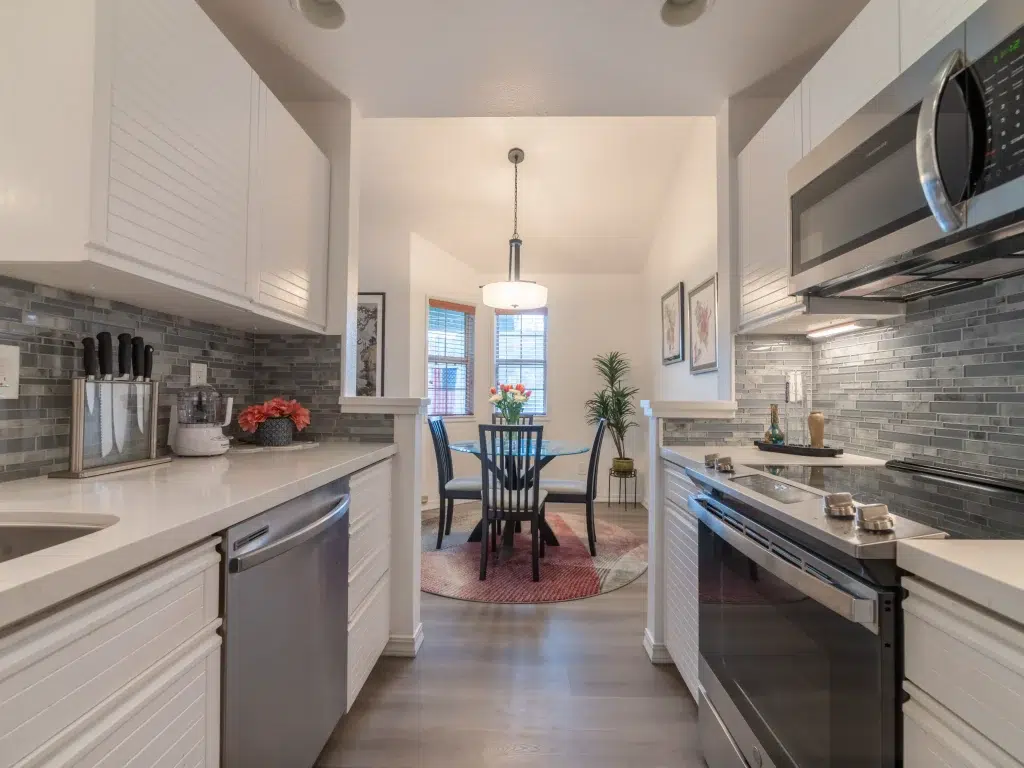Deciding between a kitchenette or a full-sized kitchen can be tricky. Your lifestyle, available square footage, and cooking habits all play crucial roles in this decision. As someone who’s helped countless homeowners make this choice, I’m sharing my insights to help you figure out which option suits your needs best. The right kitchenette setup can be a game-changer for small spaces, while a proper kitchen offers advantages for dedicated home cooks. Let’s dive into the key differences!
Understanding the Difference Between a Kitchen and a Kitchenette
The main distinction comes down to size and functionality. A full kitchen typically spans at least 100 square feet and includes standard-sized appliances with ample counter space. You’ll find room for a full-sized refrigerator, stove, oven, dishwasher, and plenty of storage options.
In contrast, a kitchenette usually measures under 80 square feet with scaled-down appliances. These compact spaces focus on efficiency rather than entertaining. A well-designed kitchenette often features apartment-sized refrigerators, two-burner cooktops instead of full ranges, and limited cabinet space. They’re perfect for singles, couples, or as secondary food prep areas in guest suites or basement renovations.

Essential Features of a Kitchenette: Appliances and Space
The beauty of a kitchenette lies in its efficiency. These compact spaces maximize functionality while minimizing footprint. Modern kitchenette designs can pack impressive utility into limited square footage through smart storage solutions and multi-purpose features.
Most kitchenettes include strategically placed outlets for countertop appliances and clever storage solutions like magnetic knife strips or hanging pot racks. The focus remains on necessity rather than luxury, making them ideal for vacation homes, studio apartments, or office break rooms where occasional meal prep happens but isn’t the primary function.
Must-Have Appliances for an Efficient Kitchenette
Every well-designed kitchenette needs these essentials:
- Mini-refrigerator or apartment-sized model (under 10 cubic feet)
- Two-burner cooktop or hot plate
- Microwave or toaster oven (ideally combination units)
- Small sink with adequate water pressure
- At least 24 inches of usable counter space
These basics ensure you can prepare simple meals without sacrificing too much space. For particularly tight areas, look for combo units like microwave-convection hybrids that serve multiple functions.
When a Full Kitchen Makes More Sense for Your Home
Full-sized kitchens make more sense for family homes, enthusiastic cooks, or frequent entertainers. If you regularly prepare meals for more than two people or enjoy complex cooking projects, you’ll appreciate the additional workspace and storage a kitchen provides.
Large kitchen spaces also typically add more value to your property than a kitchenette. For primary residences, investing in a complete kitchen usually offers better returns when it’s time to sell. Consider your long-term plans – if you might expand your family or host regular gatherings, the traditional kitchen provides necessary flexibility.
Maximizing Counter Space in Small Kitchen Designs
Even in limited spaces, smart design can dramatically increase functionality. Pull-out cutting boards, foldable countertop extensions, and wall-mounted drop-leaf surfaces add precious work area when needed without consuming permanent square footage.
Appliance placement matters tremendously in compact kitchen designs. Consider under-counter refrigerators, drawer dishwashers, or slim profile cooking appliances specifically designed for tight quarters. Vertical storage using the full wall height helps keep counters clear for actual meal preparation rather than storage.
Making the Final Decision: Kitchen or Kitchenettes?
Your lifestyle should guide this choice more than anything else. Consider how often you cook, what types of meals you prepare, and how many people you typically feed. For frequent entertainers or culinary enthusiasts, a full-sized kitchen makes sense despite the extra cost and space requirements.
For occasional cooks, singles, or those looking to outfit secondary living spaces, a kitchenette offers practical benefits. They’re less expensive to install and maintain, use less energy, and clean up more quickly. Think about your daily routine – if breakfast consists of coffee and toast while dinners are simple or often eaten out, you might be perfectly happy with a kitchenette setup.
Need help deciding which option fits your lifestyle and space? Contact us today for a free consultation on your project!

FAQ
Does a kitchenette include a fridge?
Yes, most compact cooking spaces include a refrigerator, though typically smaller than standard size. You’ll often find mini-fridges or apartment-sized models (under 10 cubic feet) that fit perfectly in these space-saving areas. Some ultra-compact designs might use undercounter refrigerators to maximize the limited square footage available.
What is inside a kitchenette?
These mini cooking areas typically contain a small fridge, two-burner cooktop, microwave or toaster oven, and a modest sink. You’ll also find limited counter space (usually 2-4 feet), minimal cabinetry for storage, and strategically placed outlets for small appliances. Many modern designs include clever storage solutions like wall-mounted organizers.
What is another name for a kitchenette?
Common alternative terms include “mini kitchen,” “compact cooking area,” “efficiency kitchen,” or “galley.” In studio apartments, they’re often called “cooking nooks” or “culinary stations.” Hotel rooms feature “wet bars” or “refreshment centers,” while office settings might refer to them as “break stations” or “coffee bars.”
